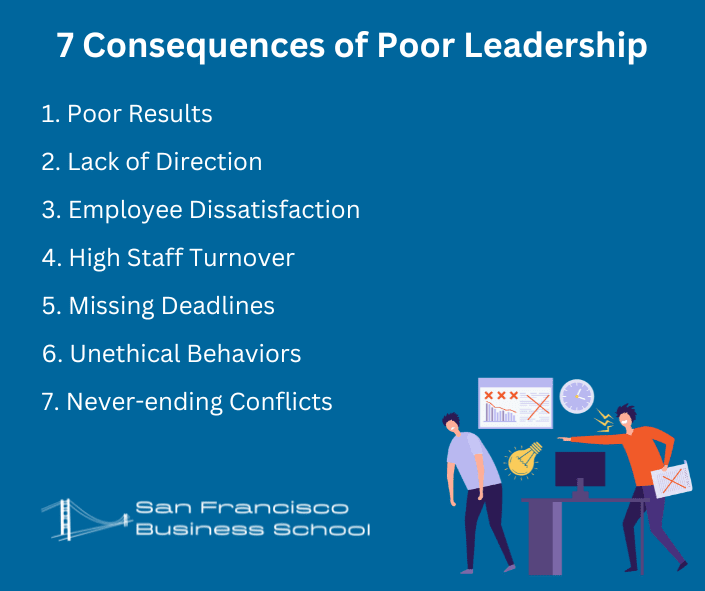7 Consequences of Bad Leadership in Businesses with Examples
Bad leadership is defined as showing no empathy, poor communication, and a lack of direction. While great leaders manage to lead their teams toward the goals and objectives of the organization, bad leaders can cause demotivation, dissatisfaction, and poor performance in businesses. We have gone through the 7 consequences of bad leadership in businesses and alarming signs of bad leadership.
In this article
📌 Hint: Do not skip this article, you will find FREE Leadership Training resources throughout the article.
There are several consequences of bad leadership in businesses. We have listed the top 7 consequences in this article. Let’s discover each of these one by one now.

1- Bad Leadership Causes Poor Results
No matter if the leader is leading a few people or an entire organization, bad leadership causes poor performance in results. The primary goals of businesses are earning money, enhancing their customer base, and increasing their market shares. However, if the business has bad leadership, it is not possible to generate good outcomes.
Businesses have missions, visions, and objectives. For instance, Amazon’s mission is to be Earth’s most customer-centric company, Earth’s best employer, and Earth’s safest place to work. Tesla’s mission is to accelerate the world’s transition to sustainable energy and its vision is to create the most compelling car company of the 21st century by driving the world’s transition to electric vehicles. Google’s mission is to organize the world’s information and make it universally accessible and useful. We can add more examples from other companies.
Leader duty is creating projects, motivations, and tasks to reach the organization’s goals and objectives. When doing this, leaders break down the organization’s mission and vision to their department level and create their own strategy to reach the company’s mission and vision. For instance, a task-oriented leader working at Tesla creates tasks, assigns them to the team, and follows the results closely. To produce good results, leaders must create a connection between the goals of the business and the self-interests of the employees. Great results come out of the strategic thinking aligned with the company’s mission and vision.
However, bad leadership fails to create a bond between the business goals and the self-interests of the employees. For instance, considering Amazon’s mission, a leader favoring more sales, and more customers rather than being more customer-centric will fail. A leader in Google trying to show more paid advertisements to the web users for more revenue rather than showing more relevant results will fail. As a result, bad leadership causes poor results and hampers the business to succeed in its mission and vision.
Enhance Your Leadership Skills – Executive Leadership Training Program
San Francisco Business School offers an online, self-paced comprehensive executive leadership training program. You can consider enrolling in this program to improve your leadership skills.
2- Lack of Direction
One of the top traits of great leaders is being a role model for their followers, inspiring them, and encouraging them to reach their goals and objectives. However, this direction and guidance towards goals is missing in bad leadership.
The business hierarchy must provide the department’s cooperation rather than competition and fights. In some businesses, you can see the departments or teams are competing with each other. For instance, if the two sales teams are targeting the same group of customer segments, they will not be willing to share their experiences and cooperate with each other. Bad leadership ignores these kinds of organizational mistakes and causes confusion among the functions of the business.
Bad leaders fail to guide, show direction, and encourage people. There are several leadership theories such as situational leadership and Blake Mouton grid. These theories identify different types of leadership and propose the best approach to lead a team. For instance, if you have an experienced and motivated team, laissez-faire leadership will be more appropriate. Because experienced and motivated employees would like to see servant leaders in their organization. However, if you have a less experienced team, if you are managing a time-critical project, an authoritative leadership style may be more appropriate. Under bad leadership, you cannot see the suitable approaches applied to lead the people.
3- Employee Dissatisfaction
Employee satisfaction is one of the key factors for creating good business results. Although there are leadership styles such as transactional leadership favoring that people do things only because of monetary expectations, many theories support that happy employees generate good results.
Bad leadership ignores the employees’ self-interests, and development and devalues them. As a result, this causes dissatisfaction among employees. Dissatisfied employees will look for other jobs, and show poor performance and this will affect the business outcomes.
You can apply an open-door policy to ensure the employees can reach out to you easily. Frequent communication with the team will make them feel that they are valued. If possible, try to get a team buy-in when making important decisions affecting your team.
4- High Staff Turnover
Bad leadership causes dissatisfaction and in turn, employees will look for alternative jobs, and this will cause a high staff turnover. Employee or staff turnover refers to the total number of workers who leave a company over a certain period. For instance, if you are leading 100 people, and if 8 people are leaving every year, the staff turnover rate is 8% for your group.
Benchmark your employee turnover rates with the industry average. Typically, in bad organizations or under bad leadership, the staff turnover rate will be higher than the average. Note that, the averages change depending on the economy, market, and other conditions, so it is better to compare against similar periods.
For instance, the following is a study by LinkedIn that shows industries with above-average turnover rates.

Imagine you are the leader of a tech company. The average staff turnover rate is 12.9%. If your business has a staff turnover rate of much more than 12.9%, this can be because of bad leadership. Sometimes, even though a business’ overall turnover rate is normal, a particular department or team’s turnover can be higher. For instance, if the company has an average turnover rate of 10%, and if a particular team has a 20% turnover rate, you should focus on that team and look for bad leadership signs.
Free Online Leadership Skills Training Program
One of the requirements to be a good leader is to improve yourself continuously. The best way to do this is, to enhance your competence through training. Take a step ahead and jumpstart your leadership competence. Enroll in our 1-hour Free Leadership Training program.
5- Missing Deadlines
Businesses run projects to reach their goals and objectives. Project management is creating a unique product or service in a pre-defined time, with a defined budget, and at the required quality levels. Successful businesses evolve as a result of successfully executed projects. For instance, for Apple, the development of the iPhone and iPad are products of a well-executed series of projects.
Bad leadership cannot define attainable targets, and this causes never-ending delays and missing deadlines. The golden rule of successful leadership is defining SMART goals. Each letter refers to a feature in SMART. S stands for Specific, M stands for measurable, A stands for attainable, R stands for realistic and T stands for Tangible. Good leadership defines SMART goals and does not allow unacceptable delays. Because delays have a cost to business as well.
6- Unethical Behaviors
Ethical leadership is doing the right things no matter the situation and conditions even if it will cause the company to lose money. Several scandals even in Fortune 500 companies like the Volkswagen emission cheat, Facebook’s Cambridge Analytica scandal, and controversies about Uber increased the importance of ethical leadership even more than before.
Volkswagen, Facebook, and Uber are just a few examples of several ethical scandals. These examples show that when people are at powerful levels, they can be greedy, and make poor ethical choices even if it will cause their companies or even themselves to end up in court. This is an inevitable result of bad leadership.
Bad leadership causes corruption, cheats, and inevitable bad results. If there is no authority, ethical values, and integrity, unethical employees may look for quick results and hacks to show results like they did something even though they did not. They might try to create fake results and reports to overcome situations.
7- Never-ending Conflicts
Bad leadership causes conflicts among teams and people in the business. If there is no clear hierarchy and if the leader does not possess effective conflict resolution skills, there can be never-ending conflicts in a business.
Conflicts are unavoidable wherever there is a human interaction. You should not be afraid of the conflicts. However, leaders must have conflict management and negotiation leadership skills.
There are five types of conflict management techniques:
- Avoiding: This is simply delaying to make a decision about the issue.
- Competing: Addressing the conflict directly and trying to solve the conflict as quickly as possible.
- Accommodating: This is resolving the issue by giving in to the opposing party.
- Compromising: This is referred to as “lose-lose” as well. Each side is pushed to make some sacrifices to reach a resolution.
- Collaborating: This method looks for “win-win” resolution. Parties look for a solution that will make everyone happy.
Leaders should use their leadership skills to overcome conflicts in the best way. Win-win may not be the ultimate outcome in some circumstances.
Watch Laura’s 30 Seconds Experience – Executive Leadership Program
Hear from Our Alumni Laura Smith, Head of Design. Laura attended the Executive Leadership Program at SFBS.
Bad Leadership Examples
We can list several examples of bad leadership. However, we listed here just two examples to give you an idea of what bad leadership can cause.
1- Enron – Biggest Chapter-11 Bankruptcy in History
The Enron scandal is for sure the top corporate scandal of all time. The scandal started in 2021 when financial analysts started to question Enron’s annual report. The reports were prepared using irregular procedures and it was not easy to track how the company was making money. Andrew Fastow and others at Enron’s bad leadership orchestrated a scheme to use off-balance-sheet special purpose vehicles (SPVs).
The SEC began to investigate the issue and found that Enron was hiding billions of dollars in liabilities through its subsidiary companies or the companies they controlled. Enron was showing in their reports that they were profitable although they had severe cash flow problems.
Enron’s share price fell from $90.56 to under a dollar as the crisis unfolded, with Enron forced to file for what was then the biggest chapter-11 bankruptcy in history.
2- Kodak – Losing the Pace of Business
The Eastman Kodak Company is an American public company that produces various products related to its historic basis in film photography. The company is headquartered in Rochester, New York, and is incorporated in New Jersey. It is best known for photographic film products, which it brought to the mass market for the first time.
Kodak employee Steven Sasson developed the first handheld digital camera in 1975. Larry Matteson, another employee, wrote a report in 1979 predicting a complete shift to digital photography would occur by 2010. However, company executives were reluctant to make a strong pivot towards digital technology, since it would require heavy investment, make the core business of film unprofitable, and put the company into direct competition with established firms in the computer hardware industry.
Even though the employees saw the potential in the digital photography space, as a result of the bad leadership, Kodak did not focus on this area. When lots of digital cameras were launched, it was too late for Kodak to react to changing business dynamics. Later on, technological advances in smartphone technology enabled us to have photo cameras in our hands. In 2010, Kodak was removed from the S&P 500.
Summary
Bad leadership causes severe consequences for businesses. The top 7 consequences are poor results, lack of direction, employee dissatisfaction, high staff turnover, missing deadlines, unethical behaviors, and never-ending conflicts. Although there are several examples of bad leadership, Enron and Kodak are the iconic ones that show the consequences of bad leadership in businesses.

